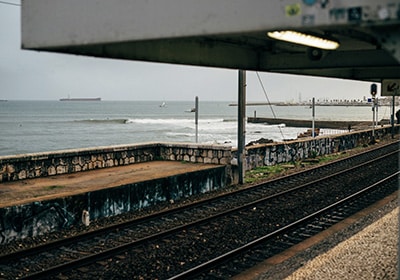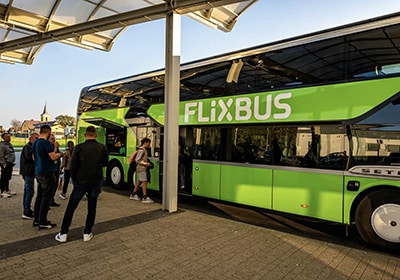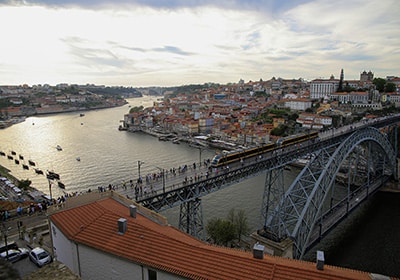Portugal offers visitors and expats a remarkable amount of diversity and charm in a surprisingly easy country to explore.
Portugal’s transportation network is accessible and easy to navigate for expats settling in or exploring. Big cities like Lisbon and Porto have well-developed public transit systems, including metro lines, buses, and trams, that make getting around straightforward and efficient.
The country’s network of national roads and railways connects cities and regions and provides a reliable way to explore the country more broadly. Taxis, ridesharing services like Bolt and Uber, and even ferries in coastal regions provide additional ways to move around.
Whether you’re commuting in the city or embarking on a cross-country adventure, understanding Portugal’s transport system will help you make the most of your time in this beautiful and easily traversable country. In this Transport Portugal guide, we will explore:
Train Portugal: Traveling by Train in Portugal
 Once you have booked your trip, met all your visa requirements for Portugal, and found accommodation, the next step is to start planning how to move around Portugal.
Once you have booked your trip, met all your visa requirements for Portugal, and found accommodation, the next step is to start planning how to move around Portugal.
Traveling by train in Portugal is a convenient and scenic way to discover the country. Train services connect major towns through a well-developed rail network, operated by Comboios de Portugal (CP), the country’s leading railway operator. The system includes long-distance, suburban, and international routes.
Train tickets can be purchased online through the official CP website, making planning easy and accessible. Portugal’s rail infrastructure supports four main types of long-distance train services. Regional trains stop at nearly every railway station, which is ideal for exploring smaller towns. Interregional trains are faster, skipping many smaller stations, while Intercidade trains are express trains that focus on nearby towns and cities.
The Alfa Pendular Deluxe is the fastest and most comfortable option, offering premium service across key routes. Lisbon and Porto also feature suburban train services that reach outlying areas, integrated with metro stations for greater convenience. For travel on international trains, the Celta train connects Porto to Vigo, Spain, daily. At the same time, another line links Lisbon to Badajoz, Spain, offering further access to other European countries via Madrid.
Whether traveling for leisure or business, the CP-operated rail network efficiently links Portugal’s diverse regions. With frequent departures, clean and comfortable coaches, and connections to central railway stations in each city, train travel remains one of the most effective ways to explore Portugal.
Traveling by Bus in Portugal
 In this part of our Transport Portugal guide, we will explore bus travel in Portugal, which is a highly effective and accessible way to explore the country. A network of bus services fall beyond the reach of the CP rail system, reaching even the smallest towns across each region of the country.
In this part of our Transport Portugal guide, we will explore bus travel in Portugal, which is a highly effective and accessible way to explore the country. A network of bus services fall beyond the reach of the CP rail system, reaching even the smallest towns across each region of the country.
Intercity travel is popular for long-distance service, with express buses operated by companies like Rede Expressos, Rodonorte, and FlixBus. These modern, comfortable buses often feature air conditioning and Wi-Fi. Timetables and ticket booking for intercity travel can be done online through company websites or apps, or at bus stations using credit, debit, or cash.
Short distances within urban areas are served by local buses, which can be boarded by purchasing a ticket on board or at kiosks. In cities like Lisbon and Porto, passengers can use the Viva Viagem card or day passes for cost-effective access. For local buses, you may need to validate your ticket when boarding.
Depending on the system, payment is generally accepted in cash or by card. Each region has its own bus network, often run by regional companies. Some have websites, and others sell tickets directly through the driver.
When traveling by bus in Portugal, be sure to keep your ticket for inspection, respect waiting lines, and signal the driver by raising your arm. Don’t hesitate to ask the driver or fellow passengers for help—bus travel in Portugal is user-friendly, flexible, and well integrated throughout urban and rural areas.
Traveling by Metro Network and Tram in Portugal
 Whether visiting or living in Portugal, traveling by metro network and tram, especially in Lisbon and Porto, is one of the quickest and most efficient ways to explore the country’s two largest cities. Lisbon and Porto have excellent metro systems in place, with frequent service and multiple lines connecting almost all key neighborhoods.
Whether visiting or living in Portugal, traveling by metro network and tram, especially in Lisbon and Porto, is one of the quickest and most efficient ways to explore the country’s two largest cities. Lisbon and Porto have excellent metro systems in place, with frequent service and multiple lines connecting almost all key neighborhoods.
If metro stations do not directly serve a destination, there is usually a tram to complete the journey. The Lisbon metro operates daily from 6:30 am to 1:00 am, including weekends and holidays, with four main lines: Blue, Yellow, Green, and Red.
Porto’s metro network is extensive and extends throughout the metropolitan area. Porto’s urban train network extends beyond the city to areas like Braga, Guimarães, and Aveiro. To use the metro, travelers tap their Viva Viagem card in Lisbon, or their Andante card in Porto, at the gates before entering and again when exiting the station. This card, essential for metro and tram use, can be loaded with Zapping for discounted fares or used to buy daily passes.
Some systems also accept contactless payments using bank cards or mobile devices. Trams, especially in Lisbon, are both practical and scenic. Lisbon’s historic tram system, with iconic wooden trams like the famous Tram 28, connects districts such as Graça, Mouraria, Alfama, and Bairro Alto.
Trams can also be found in many other major cities in Portugal and remain a popular and nostalgic way to get around.
Traveling by Car in Portugal
 In this part of our Transport Portugal guide, we will explore driving in Portugal. Driving is a flexible and affordable way to explore the country, particularly in regions less accessible by public transport. Hiring a car and not having to rely on other services can make it easy to visit each tourist attraction and the more specific regions on your list. You can explore freely and find secluded beach resorts or remote beaches, and even visit nature parks like Serra da Estrela.
In this part of our Transport Portugal guide, we will explore driving in Portugal. Driving is a flexible and affordable way to explore the country, particularly in regions less accessible by public transport. Hiring a car and not having to rely on other services can make it easy to visit each tourist attraction and the more specific regions on your list. You can explore freely and find secluded beach resorts or remote beaches, and even visit nature parks like Serra da Estrela.
Motorbike exploring Portugal is also an option, thanks to a major EU-funded construction program. The road network has been significantly improved, especially in previously remote areas such as Central Portugal.
This means that what might appear as a minor route on a map can often be a well-paved, easy-to-drive highway. The motorway in Portugal consists of four or six-lane toll roads that connect major cities like Lisbon, Porto, and the Algarve with inland towns and the north.
Most motorways have toll gates, where you take a ticket upon entry and pay a small fee at the exit. Petrol stations are readily available along these routes. In major cities, rush hour traffic can be a nightmare, especially on Sunday evenings heading back to Lisbon, as car ownership has been increasing.
However, traffic is generally light outside of peak times. In lesser-known areas, expect winding roads, and in rural parts of mainland Portugal or the Azores, you may encounter cattle blocking the road or locals carrying produce.
The rules of the road align with those of other EU countries:
- Traffic drives on the right
- Speed limits are 50kph in towns, 90kph on regular roads, and 120kph on motorways
- Vehicles coming from the right have priority unless signage states otherwise
- You must give way at roundabouts and stop at stop signs.
Traveling by Taxis, Uber, and Bolt
 Traveling by taxis, Uber, and Bolt in Portugal is convenient and offers a range of options to suit different budgets. Traditional taxis are also available, and they are pretty affordable compared with taxi fares in other Western European countries.
Traveling by taxis, Uber, and Bolt in Portugal is convenient and offers a range of options to suit different budgets. Traditional taxis are also available, and they are pretty affordable compared with taxi fares in other Western European countries.
These registered taxis are easy to find, especially in larger cities, with taxi ranks located outside airports, major train stations, and in designated city center spots. For those looking for a cheaper and more flexible alternative, ride-sharing services are popular throughout Portugal.
Uber and Bolt operate in all the larger cities and are often a preferred choice for both locals and tourists. These services are easy to use through their mobile apps and typically offer lower fares than traditional taxis. Many Uber and Bolt drivers also provide helpful local services, sharing insider tips on the best restaurants, places to visit, and hidden gems in the area.
Airports in Portugal
 In this part of our Transport Portugal guide, we will explore air travel in Portugal. Airports in Portugal provide strong international and domestic connectivity across both the mainland and the autonomous islands. Mainland Portugal has three main international airports: Lisbon Airport (Aeroporto Internacional de Lisboa Humberto Delgado), Porto Airport (Aeroporto Francisco Sá Carneiro), and Faro Airport.
In this part of our Transport Portugal guide, we will explore air travel in Portugal. Airports in Portugal provide strong international and domestic connectivity across both the mainland and the autonomous islands. Mainland Portugal has three main international airports: Lisbon Airport (Aeroporto Internacional de Lisboa Humberto Delgado), Porto Airport (Aeroporto Francisco Sá Carneiro), and Faro Airport.
These airports serve as key gateways to Portugal, connecting travelers to major European cities and other global destinations. In addition to the mainland, Portugal’s autonomous islands also have essential airports. Madeira Airport serves the island of Madeira, offering flights to and from mainland Portugal and beyond.
Several key airports facilitate air travel in the Azores, including Ponta Delgada–João Paulo II Airport on São Miguel Island, Santa Maria International Airport, and the Lajes airfield on Terceira Island. Together, these airports ensure that residents and visitors can easily access all regions of Portugal, whether traveling for business, leisure, or inter-island connections.
The Cost of Transport in Portugal
In this part of our Transport Portugal guide, we will explore the basic cost of transport in Portugal. Whether you’re planning on sightseeing or traveling to work or school, if you’re moving to Portugal from USA or any other country, knowing how to get around a new country is important, and doing your research can help you navigate key areas easily.
According to Numbeo, public transport costs are fairly affordable in Portugal. Petrol costs around €1.70, a one-way ticket on local transport costs €1,85€, and a monthly pass costs just €40.
The average starting tariff for taxi services is €3.50 and increases by €0.98 per kilometer. However, more affordable taxi fees are also available through services like Uber and Bolt.
Tips for Navigating the Transportation System in Portugal
 Navigating the transportation system in Portugal is easy with a bit of preparation and awareness. The best way to travel in Portugal is to plan ahead. Always arrive early to allow time to buy a ticket and locate the right platform, or book tickets online to save money.
Navigating the transportation system in Portugal is easy with a bit of preparation and awareness. The best way to travel in Portugal is to plan ahead. Always arrive early to allow time to buy a ticket and locate the right platform, or book tickets online to save money.
When taking the train, identify the station’s location relative to the town—it’s not uncommon for stations to lie outside the town center, which can lead to last-minute rushing. Public transport is generally efficient, and transport hubs like train stations and taxi services are widely available.
Ride-sharing services like Bolt and Uber are also accessible, and their drivers often provide insightful local tips. Friendly locals are usually happy to help with directions or advice. Compare trains and buses, including FlixBus, which offers extensive and often very cheap coverage across the country. For longer distances or off-the-beaten-path areas, renting a car can be a good option.
Prices drop if you rent for multiple days, but always check comparison sites like rentalcars.com or skyscanner.net for the best deals. Be cautious of low-cost rentals with expensive insurance. If driving, be aware of heavy traffic in cities like Lisbon and Porto, and use extra care in rural areas with narrow streets, poorly lit roads or falling rock warnings.
Why choose Global Citizen Solutions for your Immigration Visa?
GLOBAL APPROACH BY LOCAL EXPERTS
- GCS has offices located across Portugal.
- Members of the US-Portugal and UK-Portugal Chambers of Commerce in Portugal, and the Investment Migration Council (IMC).
- Our expert team can help you throughout your journey to secure your Visa.
100% APPROVAL RATE
- Our successful track record in applications provides reassurance to applicants.
- We have helped clients from more than 35 countries secure residency in Portugal.
ALL-ENCOMPASSING SOLUTION
- With a single channel of communication, our approach ensures that you have complete clarity on your application.
- Our BeGlobal® Onboarding System allows for a total flow of information.
TRANSPARENCY AND PRIVACY
- Our pricing is clear and detailed, you will not face any hidden costs.
- All data is stored within a GDPR-compliant database on a secure SSL-encrypted server.
Frequently Asked Questions about Transport Portugal
What is the best way to get around Portugal?
Portugal offers diverse transport options for exploring the country. Trains and buses are excellent choices for reaching major cities and even smaller towns, while car rentals provide greater flexibility for exploring at your own pace. Within cities, metros and trams are convenient and affordable ways to get around.
Is public transportation in Portugal reliable?
Yes, public transport is reliable and well-connected, especially in major cities like Lisbon, Porto, and Faro.
How do I use trains in Portugal?
To use trains in Portugal, you need a valid ticket for your selected route and class. Tickets can be purchased at train station ticket offices, vending machines, or online via the Comboios de Portugal (CP) website or app. The CP app is especially useful for checking timetables and managing your bookings. Train options include Alfa Pendular (AP) for high-speed connections between major cities, Intercidades (IC) for long-distance travel, Regional and InterRegional trains for broader regional coverage, and Urban trains.
Are buses a good option for traveling in Portugal?
Yes, buses in Portugal are easily accessible and reliable. A network of bus services operates beyond the reach of the CP rail system, reaching even the smallest towns across each region of the country.
Can I use Uber or other ride-sharing apps in Portugal?
Yes, Uber and Bolt operate in all the larger cities and are easy to use through their mobile apps.
Is it easy to rent a car in Portugal?
Renting a car in Portugal is relatively easy and often more affordable than in many other European countries, especially if you book in advance or travel during the off-season. To find the best options, it’s a good idea to use comparison websites like rentalcars.com or skyscanner.net. These platforms help you compare prices and rental conditions across various companies.
Do I need an international driver’s license to drive in Portugal?
If you have a valid driver’s license from an EU/EEA country, you can drive in Portugal without needing an International Driving Permit (IDP). However, if you hold a license from a non-EU/EEA country, you may need an IDP to drive legally in Portugal.
How much does public transport cost in Portugal?
Public transport costs are fairly affordable in Portugal. Petrol costs around €1.70, a one-way ticket on local transport costs €2, and a monthly pass costs just €40. The average starting tariff for taxi services is €3.50 and increases by €0.98 per kilometer.
Are taxis expensive in Portugal?
Taxi fees are affordable in Portugal, and they are also available through services like Uber and Bolt.
What is the cheapest way to travel around Portugal?
Using Portugal’s extensive network of buses and trains is the cheapest way to travel around Portugal.
Is it safe to use public transport in Portugal?
Yes, as the seventh safest country in the world according to the 2024 Global Peace Index, public transport in Portugal is generally safe and reliable.
Are there metro systems in Portuguese cities?
Yes, the two largest metropolitan areas in Portugal, Lisbon and Porto, have metro systems. These are the Lisbon Metro and Metro Transportes do Sul in the Lisbon metropolitan area and the Porto Metro in the Porto Metropolitan Area.
How do I get from Lisbon to Porto?
This will depend on your preferences, as there are several ways to travel from Lisbon to Porto, including bus, car, flights, and train trips. The most popular option is the train, which takes just over two hours.
What’s the best transport option for day trips from Lisbon?
This depends on your preference. However, trains are the most popular choice for day trips from Lisbon, as they are efficient, budget-friendly, and widely available for popular destinations like Sintra and Cascais.
How do I get to Algarve from Lisbon or Porto?
There are a number of ways to get to the Algarve from Lisbon or Porto, including train, bus, or car travel. Train services offer direct routes to Faro or Lagos, renting a car is recommended for more flexibility, and buses are also available.
Are there regional train passes in Portugal?
Yes, there are both national and regional rail passes available for purchase in Portugal.
How can tourists pay for public transportation in Portugal?
Tourists can pay for public transportation in Portugal using cash, bank cards with contactless payment enabled, or a Viva Viagem card that can be topped up with credit.
How accessible is transport in Portugal for people with disabilities?
Public transport vehicles, mainly in major cities like Lisbon and Porto, usually have reserved spaces for people with special needs. In Lisbon, Carris provides a Reduced Mobility Service on its Regular Public Service routes. Buses are fitted with low floors between the entrance and exit doors, and about half are fully accessible to passengers with reduced mobility, offering space for a wheelchair, backrests, and an access ramp. Porto’s transport operator, STCP, also has a fleet of accessible urban buses and offers buses fitted with a ramp and a reserved space for wheelchairs. All have a low floor and allow a baby buggy to travel without being folded.
Is it better to fly or take the train between cities in Portugal?
This depends on your personal preferences. However, generally, the train is considered to be better for travel between cities in Portugal as it is more affordable, comfortable, and offers a scenic experience.
How do I use the Viva Viagem card in Lisbon?
You first need to purchase one at a metro station or vending machines in Lisbon, load credit onto the card, and then you will be able to use it for travel on the metro, buses, trams, trains, ferries, and some funiculars and elevators.
What is the Andante card in Porto and how does it work?
The Andante card is a rechargeable card for public transport in the Porto Metropolitan Area. It can be used for buses, metros, and trains. The card is valid for a year, but unused trips accumulate for at least 12 months beyond the expiry date.
Are bikes a good way to get around Portuguese cities?
Cycling is a good and safe way to get around Portuguese cities and offers a unique way to experience the country’s diverse landscapes.
Is there a national transportation app in Portugal?
There is not one national transportation app in Portugal, but there are several regional and city-specific apps.
How late does public transport run in Portugal?
This depends on the region you are visiting, and you are advised to check with local transportation apps and websites for timetables. Generally, daytime buses operate from 5:00 am to 11:30 pm, and night buses run from midnight to 5:00 am. Metro lines usually operate from 6:30 am to 1:00 am, regional trains operate from 05:00 to 24:00, according to Expatica, and regional and private bus services have different operating hours.
Can I bring luggage on trains and buses in Portugal?
In Portugal, you can bring luggage on both trains and buses. One piece of hand luggage fits in the designated racks on trains, and the luggage allowance for buses depends on the operating company.
Are pets allowed on public transport in Portugal?
Yes, guide dogs are allowed on all public transport, regardless of size. Small pets are typically allowed on trains, buses, and metros, but must be kept in a carrier or on a leash.
How do I travel between Portuguese islands and the mainland?
The best option is to book a flight through Azores Airlines (SATA), the primary carrier for flights between the islands and the mainland. There are regular flights between the islands and Lisbon and Porto. Within the Azores, ferries can be used to travel between islands.
